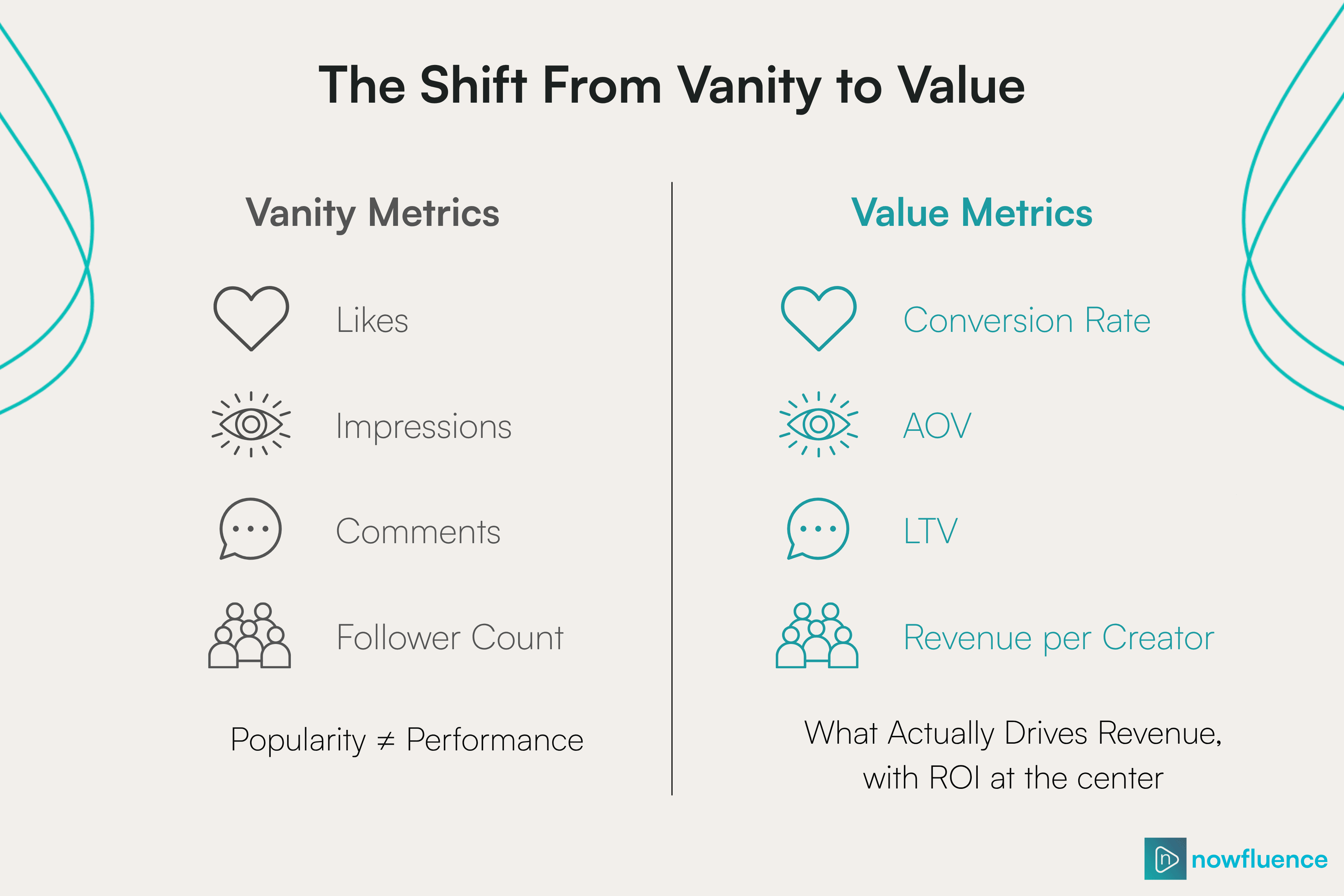The New Metrics of Influence: How AI Measures What Really Converts
Discover how AI is redefining influencer success by measuring conversions, revenue, LTV, and real ROI. Learn why brands are replacing vanity metrics with AI-powered analytics that track true performance.
November 17, 2025
For a decade, influencer marketing relied on surface-level indicators like likes, comments, and follower counts. These vanity metrics shaped budgets and partnerships, but as multiple industry reports show, they rarely reflected true business impact. Today, AI is ushering in a new era defined not by popularity but by performance.
According to Later’s 2025 analysis of AI in influencer marketing, brands are rapidly shifting toward metrics that capture actual commerce outcomes, not just engagement behavior. Similarly, City Girl Strategy’s 2025 ROI report highlights that the most successful brands are those measuring conversions, revenue, and customer quality rather than impressions alone. This mirrors a broader transformation in the industry, where AI-powered attribution is becoming the foundation of modern influencer strategy.
AI is redefining what influence means, and for the first time it is measurable.
Why Engagement No Longer Predicts Influence
Engagement rates were once the centerpiece of influencer marketing, but AI models and industry research have exposed their limitations. Later’s report on AI-powered influencer analytics notes that engagement often reflects platform algorithm behavior rather than actual buyer intent. High engagement does not guarantee high-performing campaigns, and historically, it has misled brands into overvaluing creators who perform well socially but not commercially.
The turning point comes from AI’s ability to link audience behavior directly to purchasing outcomes. Data is no longer siloed. Creator activity can now be connected to Shopify storefront performance in real time, revealing:
- Which creators actually convert
- Which audiences respond with high purchase intent
- Which posts drive meaningful actions rather than superficial interaction
This shift echoes insights from City Girl Strategy’s ROI framework, which argues that brands who still prioritize engagement over conversion risk misallocating budgets and missing high-value opportunities.
AI Unlocks the Metrics That Truly Matter
Conversion Metrics That Reflect Real Buyer Behavior
AI enables precise tracking of the full funnel, showing how many viewers actually transition from content consumption to purchase. These insights redefine performance benchmarks far beyond likes or impressions.
Revenue Per Creator
City Girl Strategy emphasizes the importance of understanding revenue to produce a true measurement of ROI. AI makes revenue attribution possible even across multi-channel journeys, allowing brands to see which creators generate measurable economic impact.
Average Order Value (AOV)
House of Influencer Marketing’s glossary defines AOV as one of the strongest indicators of the quality of the customers creators bring in. When AI models connect AOV to specific influencers, brands gain a clearer understanding of not just how much a creator sells, but the value of those sales.
LTV Contribution
AI can now predict whether customers sourced by specific creators will return. This metric reveals long-term influence rather than one-time spikes, aligning influencer acquisition with broader business profitability.
ROI and ROAS in Real Time
Instead of static end-of-campaign reporting, AI continuously calculates ROI based on verified creator data and real-time commerce analytics. This transforms influencer marketing into a dynamic performance system rather than a retrospective analysis exercise.
These are the metrics of influence that matter in 2026, metrics tied to revenue, not reactions.
From Vanity Metrics to Verified Commerce Impact
The transition away from vanity metrics is driven by two forces:
- AI’s ability to expose their limitations
- A rising demand for authenticity and verifiable performance
Later’s analysis highlights that AI reduces reliance on inflated or manipulated engagement data, which historically misrepresented true creator influence. Meanwhile, City Girl Strategy stresses that brands measuring sales, not likes, see significantly higher ROI in their campaigns. Together, these studies illustrate a market-wide shift toward data integrity.
At the platform level, solutions like nowfluence reinforce this shift through AI-verified creator metrics and Shopify-integrated attribution pipelines. Every metric pulled into the platform is authentic, API-sourced, and mapped to real commerce events, eliminating the guesswork that defined earlier eras of influencer marketing.
This theme aligns directly with our previous article “The Creator Data Revolution: Why Verified Metrics Are the New Currency of Trust”, which you can reference within this post for deeper insight into how verified data reshapes the industry.

The Brands Who Adopt AI Early See the Biggest Advantage
Influencer marketing is evolving into performance commerce. Brands that embrace AI-based analytics gain a strategic advantage proven across multiple industry reports.
They see:
- Higher ROI due to smarter creator selection
- Lower CAC through better audience-target matching
- Better revenue quality from influencers who bring repeat buyers
- Real-time insights that enable mid-campaign optimization
- Predictive modeling that reduces budget waste
These are the foundations of the AI-powered influencer operating system we discussed in “From Likes to Revenue: How AI Turns Influencer Marketing Into Performance Commerce”.
Additionally, for readers who want to understand the infrastructure behind this shift, you can also read “Inside the AI-Powered Influencer OS: Why Marketing Automation Needs a Brain”.
Final Takeaway
Influence used to be defined by how loudly someone could speak online. Today, AI measures the impact of what they actually move.
Engagement is no longer the signal of success.
Conversions, LTV, and ROI are.
As both Later and City Girl Strategy emphasize, brands that adopt AI-powered attribution will outperform their competitors, spend more efficiently, and build creator partnerships grounded in real commerce impact.
This is the new definition of influence, measurable, verifiable, and powered by AI.
Want to discuss insights from this study? Reach out to our research team.